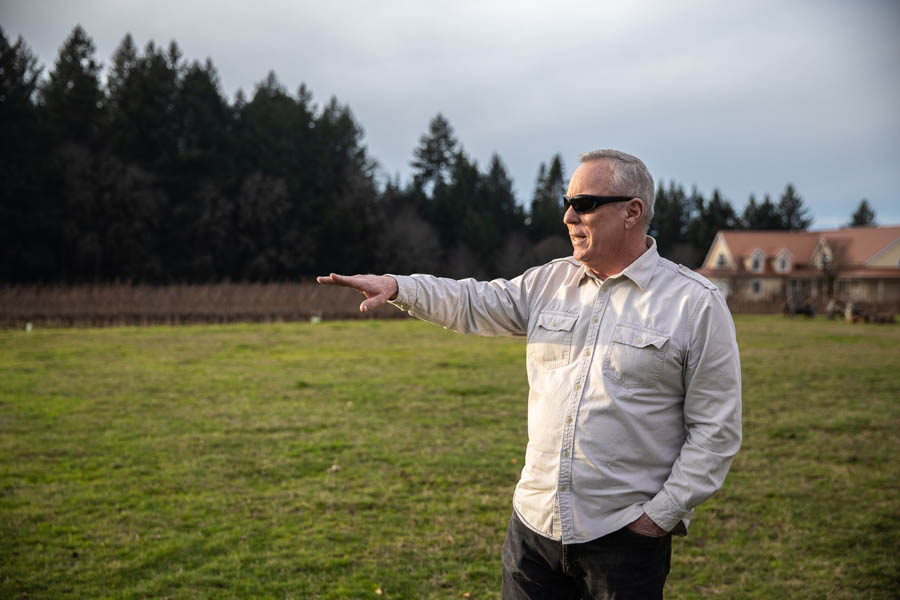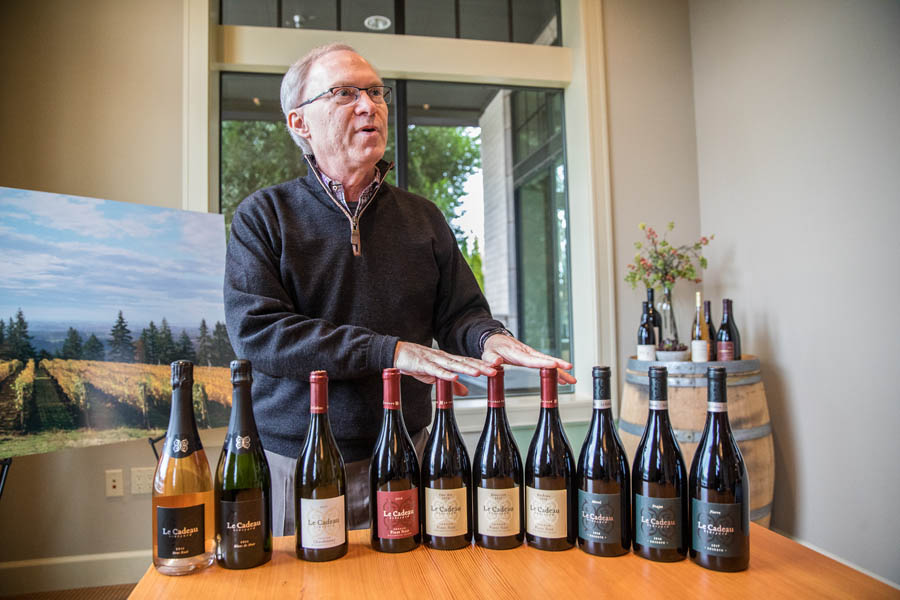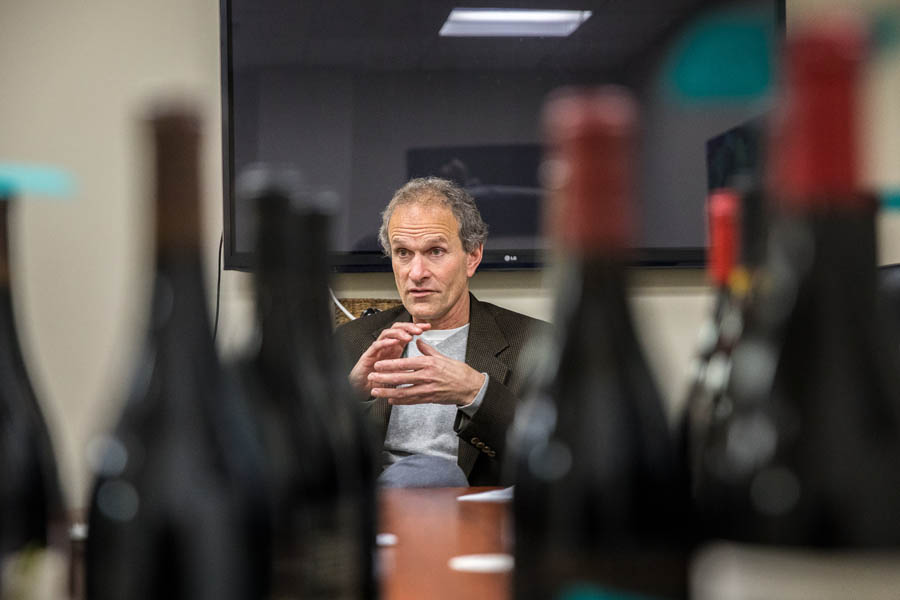The good news around Oregon’s wine industry just keeps flowing. But how long can this party last?
Dan Warnshuis hates the dirt road leading up to Utopia, his winery in Newberg, Oregon.
An energetic one-man show, the former tech sales professional from California does not just own Utopia. He is also the winemaker, cellar manager, chief marketer, webmaster, tasting room staff, vineyard manager and tractor driver.
He bought the 16.8 acres in the Ribbon Ridge American Viticultural Area in 2000, back when just 110 wineries dotted the Willamette Valley.
Today Utopia is a well-regarded, small label, selling the 3,000 cases of wine it produces each year the same way most of Oregon’s small wine labels do: directly to the consumer.
That means the best way for Warnshuis to boost sales is to draw customers to his hilltop tasting room so he can put his story in their ears and his wine in their mouths. Usually they leave with a bottle, a case or, even better, a subscription to his wine club.
The high-touch sales model works. But two decades later, competition from Oregon’s now nearly 800 wineries makes enticing people up the hill that much harder.
The unpaved road makes it nearly impossible.
 Dan Warnshuis, owner of Utopia winery in Newberg. Photo: Jason E. Kaplan
Dan Warnshuis, owner of Utopia winery in Newberg. Photo: Jason E. Kaplan
The explosive growth of the state’s wine industry is well documented. The Oregon Wine Board estimates that somewhere between 24 and 44 new wineries open every year, and large, outside investors continue to buy large chunks of established properties.
While there has been plenty of hand-wringing around this growth ruining Oregon wines, it appears the much-feared dilution of the state’s brand has been greatly exaggerated.
Instead the market seems more bullish on Oregon wine than before, even as the big players in California and Washington start to feel the pressures of oversupply and shifting demographics, according to Silicon Valley Bank’s 2020 “State of the Wine Industry” report.
Tasting room visits, the bread and butter for small producers, are down in California’s famed Napa and Sonoma regions but have doubled over the past five years in Oregon. Even Warnshuis reports serving 7,000 visitors last year.
Which might offer a clue to why he cannot get Yamhill County to pave his road.
“They resent the wineries,” he says. “I heard just this year that I’m not a ‘real farmer.’” (Yamhill County did not respond to emailed questions about the issue.)
It is a retort winery owners heard more commonly 10 years ago that, apparently, still exists today. (And now extends to the state’s growing league of cannabis farmers.) But land-use challenges are just one on a list of trials facing Oregon’s wine industry.
Small producers — which make up 70% of Oregon wineries, according to the Oregon Wine Board — contend with labor shortages, shrinking distribution channels and regulations that complicate out-of-state sales, all while they try to remain relevant in an ever-evolving market bent on seeking out new experiences and flavors (marijuana tasting rooms and a White Claw hard seltzer, anyone?).
And staying ahead of 44 new wineries a year.
“It’s one of the most brutally competitive categories I’ve ever seen, and I worked for Starbucks and Coke,” says Tom Danowski, president of the Oregon Wine Board. Yet Danowski reports that demand for Oregon wine has never been stronger, despite being more expensive than the average bottle sold on the shelf today and harder to find than comparable ultra-premium wines from other regions.
From all reports, Oregon’s wine cache looks bulletproof. But can it be sustained, particularly for those iconic, family vineyards?
About 10 miles to the southeast of Utopia, Tom Mortimer, proprietor of Le Cadeau Vineyard, does not see the growing number of Oregon pinot producers as competition. “My competition is people who make wine for people who’ve never had pinot and don’t know they should be drinking it,” he says from behind the polished stone bar of his Dundee tasting room.
“The 349 million cases of wine sold in the U.S. per year that are not from Oregon? That’s my competition.”
Case in point, Le Cadeau’s tasting room is one of four tucked inside hotel Inn at Red Hills. Mortimer begrudges no customer who walks past his door on their way to another room.
His casual attitude probably stems from his sales model: Only one-third of the 4,000 cases Mortimer produces is sold directly to consumers. The rest go through a network of distributors. “It’s unusual for a winery of our size,” he admits.
The shrinking number of distributors makes Le Cadeau’s model even more remarkable. Two decades ago, there were 3,000 U.S. distributors bringing wine, beer and spirits to stores and restaurants.
 Tom Mortimer, owner of Le Cadeau winery. Photo: Jason E. Kaplan
Tom Mortimer, owner of Le Cadeau winery. Photo: Jason E. Kaplan
Today there are around 700. The consolidation mostly rewards big producers, 10,000 cases or more, which already have a lot of marketing clout behind them.
“Distributors don’t do a lot of the selling anymore,” explains Steve Lutz, owner of Lenné Estate, another small label in Yamhill. “That’s still up to the wineries.”
Going through the distributor model puts Le Cadeau in 20 U.S. markets and three countries. Mortimer selectively targets fine-wine shops, top restaurants and exclusive country clubs for his bottles, which retail between $40 and $80, looking for “places that can hand-sell our wine and explain who we are.”
The distributor model may give Mortimer more reach, but it doesn’t make his workload easier. Not only does he pay these middlemen a cut of the profits, he still has to go out on the road and peddle his wines. Back home a staff of seven full-time, part-time and contract employees, plus wife Deb, work the rest of the operation.
Far from a burden, Mortimer sees the distributor model as an investment. For him, it is a way to bring customers to his tasting room, get them on his mailing list, entice them to join his wine club and generally raise awareness about Oregon wines.
That awareness is already strong, thanks to a wine region that consistently punches above its weight. Oregon’s industry is small, producing only 1% of the domestic market and a nearly infinitesimal .15% of the global market.
Yet it is highly regarded by experts and enthusiasts. Twenty percent of Wine Spectator’s 90+ rated domestic wines between 2015 and 2017 were from Oregon. The same publication named five Oregon wines to their 2019 list of top 100 wines in the world. “Our share of heart is much bigger than our actual share of market,” says Mortimer.
The buzz helps feed demand, according to Danowski. “Nielsen scanner data tells us one of our biggest problems is consumers not seeing enough Oregon wine on their shelves,” he says. For this reason, he welcomes investments from large, out-of-state entities.
“They bring a sales organization 200- to 300-people strong that are now out there advancing Oregon,” he says. “That helps everyone from Tom Mortimer to our biggest wineries.”
And it doesn’t look like these big purchases will dilute the moniker and mystique of Oregon wines anytime soon. “Most of this investment is coming from those [who have been] in the wine industry for generations,” says Byron Marlowe, clinical assistant professor and coordinator for wine beverage business management at Carson College of Business, Washington State University.
“They’re coming for the quality grapes. That’s what they’re buying, so they want to protect it.”
Much of these grapes, particularly from Southern Oregon, end up in the bulk market, according to Marlowe. He sees no issue with blending bulk grapes and estate grapes from the northern Willamette Valley into one product, as long as it is labeled correctly.
“Erath uses [both bulk and estate-grown grapes] and calls it ‘Oregon pinot noir.’ It’s not an ultra-premium wine, but it’s helping get the name Oregon out to the 50 states.”
And don’t confuse “bulk” with “cheap.”
“You’re not going to find any Oregon wines in the deeply discounted, wine-in-a-box format,” insists Danowski. He points to the costs of farming, where steep, muddy hilltops make mechanization hard, and skilled hands must touch the grapes between 10 and 12 times a season, as an insulating force.
The result yields a pricier product. The typical bottle of Oregon wine costs between $20 and $30, far more than the below $10 the average consumer pays. Even less expensive options from the state’s biggest players — think Acrobat, Erath and A to Z — cannot hit a price point under $10, but they get close, averaging about $16 a bottle.
Danowski insists the state needs a balance of both pricey estate bottles and less expensive pours to maintain a healthy market. “We don’t want to be so precious and special that we’re niched into a high-end market with limited growth,” he says.
He likens the bigger, more affordable brands to snowplows, penetrating entry-level price points and clearing the way for the more rarified Oregon wines.
Hopefully while people are still interested in drinking the stuff. Oregon wine does not just compete with wine from other states or countries. It also competes with a growing sector of alcoholic beverages.
 Oregon Wine Board president Tom Danowski. Photo: Jason E. Kaplan
Oregon Wine Board president Tom Danowski. Photo: Jason E. Kaplan
Store shelves are lined with a dizzying array of beer, cider, spirits, hard seltzers and alcoholic kombucha, all trying to capture a mercurial market that shows little allegiance to any one product category, let alone any one brand.
Union Wine, the state’s largest winery, is trying to appeal to these elusive consumers by offering its product for single-use consumption, also known as putting wine in a can.
“Canned wine is no longer a trend, it’s a category,” says Ryan Harms, founder and owner of Union Wine Company, via email. “Sales growth…has been extreme for us.” Between 2017 and 2018, Union increased cans by a whopping 94%. As of 2018, 55% of their wine goes into cans to be sold under their Underwood label.
It is a savvy marketing move, according to Danowski, that creates a way into the category for people who “never owned a corkscrew in their life.”
Those who do own a corkscrew and a subscription to a wine or food publication or two already know about Oregon. They have read the reviews, devoured the blogs, and now they want to visit and sample the wine at the source.
That wine tourism is as important to the small-vineyard owner as it is to the state, generating $790 million in economic impact yearly.
But too much tasting-room traffic can lead to a hangover as the local agricultural community starts to resent the constant parade of limos, congestion and noise. Northern California has already put in place strict restrictions around how many people can visit its tasting rooms and still contends with traffic jams, despite the declining number of winery visits.
To get ahead of the problem, Oregon’s wine community supported legislation in 2013 that put some “sensible restrictions on how many event days you can have at your winery,” says Danowski. “The tourism economy is important, but it’s also important to not overmilk that cow.”
The state’s impressive population growth also exerts land-use pressures. As implausible as it might sound now, Marlowe worries that Portland’s growth might make areas that produce quality pinot look more attractive as residential or commercial sites.
It also concerns Utopia’s Warnshuis. “Every year there’s a push to expand the urban growth boundary,” he says. “You have a choice; you can have condos on these hills or grapevines.”
It is an interesting puzzle. The same density that threatens to encroach on vineyards also makes the direct-to-consumer model possible for northern Willamette Valley wineries. Locals and tourists alike can easily spend an afternoon in wine country discovering new vineyards or visiting old favorites and be back in Portland for dinner that night.
“That model doesn’t work in Eastern Washington,” laments Marlowe.
The recently released 2020 Direct-to-Consumer Wine Shipping Report confirmed Marlowe’s lament. The report found that Oregon wineries shipped almost 100,000 more cases directly to U.S. consumers than neighbors to the north, despite the industry being less than two-thirds its size.
The report also found that more Oregonian wine is being shipped to more Oregonians than ever, citing a 24% increase since 2018.
Despite his challenges, Warnshuis is not giving up or slowing down. He hosts a variety of events, from small dinners to OMSI star parties at his vineyard, and added amusements such as bocce ball courts and cornhole stations, while his daughter, Utopia’s only full-time employee, amplifies the company’s social media presence, all to attract experience-seeking millennials up the dirt road to his tasting room.
Even though Warnshuis reports a small dip in sales over the past two years, he is optimistic about the future. He just purchased 37 wooded acres up the road from Utopia and converted the existing commercial woodshop and horse arena into a new winery.
“I did my crush there this year and have three or four clients that make their own wines there too,” he says. He plans to plant 15 more acres of grapes as soon as the land is cleared.
When it is mature between seven and 10 years from now, Warnshuis estimates his production will come to a total of between 5,000 and 6,000 cases of wine a year. Utopia will still be a small winery, with small-winery problems.
Warnshuis will still have to contend with the headaches of compliance, which demand he report sales in each state individually. “I spent three hours doing my Michigan taxes, and it was $14,” he says.
He’ll also have to deal with rising labor costs, or labor crews that just do not show up because the hemp harvest, which happens at the same time as the grape harvest, pays better.
And there are always emerging challenges on the horizon. Smoke taint has already claimed some of Southern Oregon’s harvest, and longer fire seasons threaten to make the problem worse.
The Washington State University’s Marlowe also worries about strong odors from cannabis operations, or weed taint, altering the taste of grapes. The professor even hints at possible competition from marijuana tasting rooms, a small-scale trend he is seeing in California and Colorado.
Lenné’s Lutz also worries about what the next economic cycle will bring to small labels like his. “It is sustainable for the moment, but when the next recession hits, we are going to feel the pain.”
Marlowe agrees that a recession may be the only thing that could hurt Oregon’s industry, as people trade down from an ultra-premium bottle to something more affordable, or cull their number of wine club memberships.
Right now, however, demand remains high, tasting-room visits are up and there is unprecedented growth in the ultra-premium category, according to Marlowe. Oregon’s wine industry is enjoying its Goldilocks moment: established enough to maintain buzz yet small enough to seem like an exclusive discovery.
The next economic downturn may bring some consolidation, but as long as people continue to drink wine, Oregon will be on the menu.
To subscribe to Oregon Business, click here.







